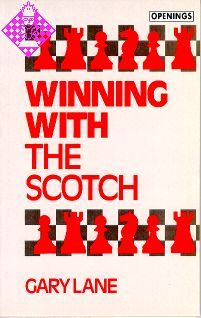Artikelnummer
LOLANWWTS
Autor
Winning with the Scotch
144 Seiten, kartoniert, Batsford Chess, 1994
Aus der Reihe »Winning with the ...«
Final vergriffen
In the 1990 World Championship match Gary Kasparov shocked the chess world with his adoption of the unusual Scotch Opening, which had for many years been considered a poor relation to the Ruy Lopez (or Spanish Game). However, in that match and subsequently, Kasparov has introduced a variety of exciting new tactical ideas that have completely transformed the reputation of the Scotch into a powerful winning weapon, and it is now highly fashionable at both grandmaster, tournament, and club level.
"His presentation is beautifully clear. Anyone who spends a little time on this book will play the better for it."The Daily Telegraph (London)"A complete course for anyone of club strength or greater to master the essentials of this most subtle opening."
·Dynamic opening popularized by World Champion Gary Kasparov
·Completely annotated games illustrate the main ideas
·Every important variation included, with an emphasis on currently fashionable system of attack and defence
Gary Lane is one of the new generation of talented young English International Masters. Since winning the Commonwealth Championship in 1988, he has competed with distinction in tournaments throughout Europe and has already established a fine reputation as a chess author. His first book for Batsford, The Ruy Lopez for the Tournament Player, was enthusiastically received by the chess press:"His presentation is beautifully clear. Anyone who spends a little time on this book will play the better for it."The Daily Telegraph (London)"A complete course for anyone of club strength or greater to master the essentials of this most subtle opening."
The Spectator (London)
| EAN | 0713472111 |
|---|---|
| Hersteller | Batsford Chess |
| Medium | Buch |
| Erscheinungsjahr | 1994 |
| Autor | Gary Lane |
| Reihe | Winning with the ... |
| Sprache | Englisch |
| ISBN-10 | 0713472111 |
| Seiten | 144 |
| Einband | kartoniert |
006 Symbols
007 Preface
009 Historical Introduction
011 1. Classical Variation: 7.Bc4
026 2. Classical Variation: 7.g3
033 3. Classical Variation: Other Lines With 5.Be3
037 4. Classical Variation: 5.Nb3
054 5. Classical Variation: 5.Nf5
061 6. Classical Variation: 5.Nxc6
064 7. Scotch Four Knights
082 8. Mieses Variation: 8...Nb6
093 9. Mieses Variation: 8...Ba6 9.b3
104 10. Mieses Variation: 8...Ba6 9.Nd2
115 11. Mieses Variation: 8...Ba6 9.Qe4
118 12. Mieses Variation: Other Lines
124 13. Neo-Mieses Variation
128 14. Steinitz Variation: 4...Qh4
134 15. Other Black Defences
142 Index of Variations
007 Preface
009 Historical Introduction
011 1. Classical Variation: 7.Bc4
026 2. Classical Variation: 7.g3
033 3. Classical Variation: Other Lines With 5.Be3
037 4. Classical Variation: 5.Nb3
054 5. Classical Variation: 5.Nf5
061 6. Classical Variation: 5.Nxc6
064 7. Scotch Four Knights
082 8. Mieses Variation: 8...Nb6
093 9. Mieses Variation: 8...Ba6 9.b3
104 10. Mieses Variation: 8...Ba6 9.Nd2
115 11. Mieses Variation: 8...Ba6 9.Qe4
118 12. Mieses Variation: Other Lines
124 13. Neo-Mieses Variation
128 14. Steinitz Variation: 4...Qh4
134 15. Other Black Defences
142 Index of Variations
In the 1990 World Championship match Gary Kasparov shocked the chess world with his adoption of the unusual Scotch Opening, which had for many years been considered a poor relation for the Ruy Lopez. However, in that match and subsequently Kasparov has introduced a variety of exciting new tactical ideas which have completely transformed the reputation of the Scotch into a powerful winning weapon and it is now highly fashionable at both grandmaster, tournament and club level... Young English International Master Gary Lane deals with every important variation, with an emphasis on currently fashionable systems of attack and defence.Fernschach
Als Gambit mag Schottisch auf Polerio (1590) zurückgehen, und Del Rio hat die Eröffnung 1750 kurz erwähnt, ihren Namen verdankt sie dem Korrespondenz-Wettkampf zwischen London und Edinburgh der Jahre 1824 bis 1828, wobei Englisch als Bezeichnung angebrachter wäre als Schottisch, weil es London war, das mit der Eröffnung einer Empfehlung von Cochrance gefolgt ist. Doch Edinburgh war beeindruckt, folgte dem Beispiel der Engländer und gewann das Match. Populär war die Eröffnung dann mehr als 20 Jahre, meist in seiner Gambitform, und Jaenisch bezeichnete sie als stärkste aller Eröffnungen.
Danach ging es auf und ab. Spanisch verdrängte Schottisch zeitweilig ganz und gar. Steinitz sorgte mit 4. ...Dh4 dafür, daß es lange dabei blieb, und Capablanca festigte das Urteil, das Schottisch remisverdächtig sei. Nun ist Schottisch wieder populär. Zu verdanken ist das dem WM. Kasparow schuf die Sensation mit der 14. Partie des WM-Kampfes von Lyon 1990. Sein Beispiel machte rasch Schule, und heute sieht es so aus, als erlebe Schottisch eine neue Blütezeit, und das 165 Jahre nach seiner Einführung in die Turnierpraxis.
Gary Lane hat sich nicht lange mit historischen Reminiszenzen aufgehalten. Er offeriert gründlich kommentierte Partien aus der Praxis unserer Tage, und der Leser hat die Wahl, in sorgfältig erforschten Abspielen neue Wege zu suchen oder eine Fülle taktischer Komplexe, die sich gleichsam am Rande der ausdiskutierten Varianten ergeben, auf Hieb und Stich zu erproben.Ludwig Steinkohl, Rochade Europa 8/93
Danach ging es auf und ab. Spanisch verdrängte Schottisch zeitweilig ganz und gar. Steinitz sorgte mit 4. ...Dh4 dafür, daß es lange dabei blieb, und Capablanca festigte das Urteil, das Schottisch remisverdächtig sei. Nun ist Schottisch wieder populär. Zu verdanken ist das dem WM. Kasparow schuf die Sensation mit der 14. Partie des WM-Kampfes von Lyon 1990. Sein Beispiel machte rasch Schule, und heute sieht es so aus, als erlebe Schottisch eine neue Blütezeit, und das 165 Jahre nach seiner Einführung in die Turnierpraxis.
Gary Lane hat sich nicht lange mit historischen Reminiszenzen aufgehalten. Er offeriert gründlich kommentierte Partien aus der Praxis unserer Tage, und der Leser hat die Wahl, in sorgfältig erforschten Abspielen neue Wege zu suchen oder eine Fülle taktischer Komplexe, die sich gleichsam am Rande der ausdiskutierten Varianten ergeben, auf Hieb und Stich zu erproben.Ludwig Steinkohl, Rochade Europa 8/93

